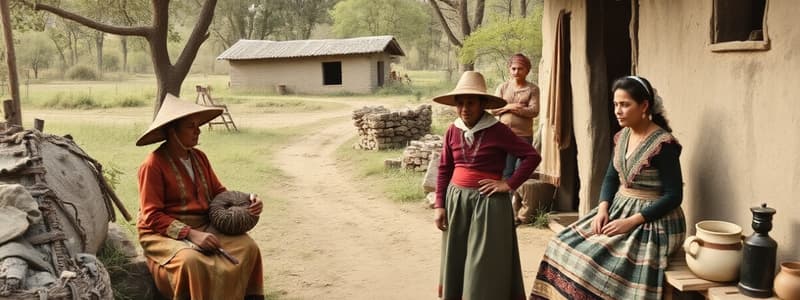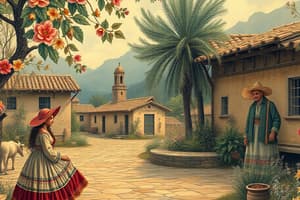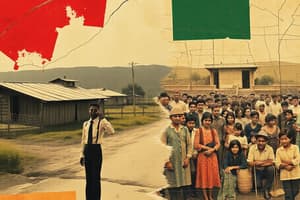Podcast
Questions and Answers
What was the common response of the coachman when faced with robbers?
What was the common response of the coachman when faced with robbers?
- To remain neutral (correct)
- To fight back fiercely
- To call for help
- To attempt to escape
Overnight lodging in rural areas improved significantly during the early post-independence years.
Overnight lodging in rural areas improved significantly during the early post-independence years.
False (B)
What type of conditions did William Marshall Anderson find in one southern village during his visit to Mexico?
What type of conditions did William Marshall Anderson find in one southern village during his visit to Mexico?
A miserable grass covered shanty
French troops reportedly behaved __________ than American troops of 1846-48.
French troops reportedly behaved __________ than American troops of 1846-48.
Match the following elements to their respective contexts in post-independence Mexico:
Match the following elements to their respective contexts in post-independence Mexico:
Life for the average citizen in rural Mexico changed significantly during the 1850s, 1860s, and 1870s.
Life for the average citizen in rural Mexico changed significantly during the 1850s, 1860s, and 1870s.
In terms of earning power, standard of living, diet, life expectancy, and ______, the life of rural Mexicans during the Empire and the restored republic closely mirrored the past.
In terms of earning power, standard of living, diet, life expectancy, and ______, the life of rural Mexicans during the Empire and the restored republic closely mirrored the past.
Which of the following is NOT mentioned as a way in which rural communities engaged with national changes?
Which of the following is NOT mentioned as a way in which rural communities engaged with national changes?
What specific aspect of the Mexican social landscape does Francisco Pimentel's 1865 description highlight?
What specific aspect of the Mexican social landscape does Francisco Pimentel's 1865 description highlight?
Match these groups to their descriptions:
Match these groups to their descriptions:
What was the common strategy employed by the coachman when confronted by robbers?
What was the common strategy employed by the coachman when confronted by robbers?
Overnight lodging in rural areas was luxurious and comfortable immediately after independence.
Overnight lodging in rural areas was luxurious and comfortable immediately after independence.
What type of sentiments did indigenous and mixed-race campesinos begin to express in Oaxaca?
What type of sentiments did indigenous and mixed-race campesinos begin to express in Oaxaca?
William Marshall Anderson found that accommodations in one southern village consisted of a __________ covered shanty.
William Marshall Anderson found that accommodations in one southern village consisted of a __________ covered shanty.
Match the following groups with their actions in post-independence Mexico:
Match the following groups with their actions in post-independence Mexico:
Flashcards
Robbery
Robbery
The act of stealing goods or money, often through violence or threat.
Neutral Behavior
Neutral Behavior
Behavior that is passive and does not actively resist or oppose something.
Miserable Shanty
Miserable Shanty
A basic, humble, and often uncomfortable place to stay.
Violent Depredation
Violent Depredation
Signup and view all the flashcards
Mix of Liberalism, Conservatism, and Tradition
Mix of Liberalism, Conservatism, and Tradition
Signup and view all the flashcards
Rural Life in Mexico (1850s-1870s)
Rural Life in Mexico (1850s-1870s)
Signup and view all the flashcards
Social Divide in 19th Century Mexico
Social Divide in 19th Century Mexico
Signup and view all the flashcards
Adaptation to National Changes
Adaptation to National Changes
Signup and view all the flashcards
Pimentel's Observation of Contrasting Worlds
Pimentel's Observation of Contrasting Worlds
Signup and view all the flashcards
Rural Society in 19th Century Mexico
Rural Society in 19th Century Mexico
Signup and view all the flashcards
Adaptation of National Changes in Rural Mexico
Adaptation of National Changes in Rural Mexico
Signup and view all the flashcards
The Enduring Divide in Mexico
The Enduring Divide in Mexico
Signup and view all the flashcards
Life in Rural Mexico (1850s-1860s)
Life in Rural Mexico (1850s-1860s)
Signup and view all the flashcards
Adaptation to National Changes (Rural Areas)
Adaptation to National Changes (Rural Areas)
Signup and view all the flashcards
Pimentel's Observation of Contrasting Worlds (1865)
Pimentel's Observation of Contrasting Worlds (1865)
Signup and view all the flashcards
Study Notes
Rural Life in Mid-19th Century Mexico
- Mexico remained largely rural in the 1860s and 1870s.
- Rural life for the average person changed little compared to previous generations.
- Those in indigenous villages or pueblos lived similarly to their ancestors, in terms of earning power, standard of living, diet, life expectancy, and education.
- Interactions with national changes often involved adapting the new to the old, especially in the political sphere.
- The gap between rich and poor, white and brown Mexicans, widened or remained significant.
- Foreign travelers noted that roads improved slowly, but bandits still plagued the highways.
Class Differences in Mexico
- Inequality between social classes persisted.
- Indigenous and mixed-race campesinos (rural farmers) increasingly developed nationalist, collective identities combining old customs with new ideas from political, religious, and social movements.
- Some Mexicans expressed desires for change or challenged established norms.
- The situation of former soldiers was often precarious following the end of conflicts, leading to banditry and social unrest.
Population and Social Problems
- Mexico's population growth was slow during periods of war and unrest.
- Some Mexican city populations decreased, but others grew, such as Mexico City.
- Birth rates remained relatively high, but high infant mortality and casualties slowed overall growth.
- Urban migration may have contributed to challenges in the cities.
- Rural poverty persisted throughout this era.
Urbanization and Development
- Mexico City's population increased to around 200,000 in the restored republic.
- Significant physical transformations occurred, particularly the construction of new avenues and thoroughfares connecting the city.
- The major boulevard, Paseo de la Reforma (formerly Calzada de la Emperatriz), was completed later in this period.
- Issues of social and moral concern arose in Mexico City, including prostitution, begging, and significant concerns about public order and moral issues.
- New thoroughfares like the one connecting Chapultepec Castle to the city center reflect the expansion of the city.
Everyday Life and Cultural Achievements
- Rural Mexicans and urbanites both had significant social diversions
- Popular culture activities like public gatherings, fiestas, and circuses enjoyed widespread participation
- The bullfight, a popular spectacle, was a part of Mexican culture, became a source of social commentary, with efforts to regulate and restrict it.
- However, social problems such as begging persisted and there was pressure to address public order and moral issues.
Social and Cultural Developments
- The mid-19th century saw a rise in historical novels, reflecting new approaches to understanding the past. Authors tried to promote a sense of Mexican identity, and awareness.
- Intellectuals favored a path that emphasized Mexican cultural values and identity.
- The mid-19th century saw innovative works in art and music, and in the development of Mexican philosophies.
- Social awareness in the arts during this period was evident in several works, which highlighted issues of poverty, inequities and social injustices.
- Positive developments were seen in avenues of higher education in the arts.
Studying That Suits You
Use AI to generate personalized quizzes and flashcards to suit your learning preferences.




